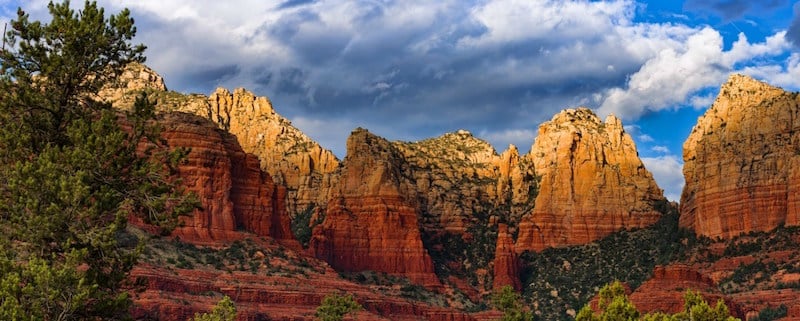Nestled in the heart of Arizona is the small desert town of Sedona. It is well known for its beautiful landscape, iconic red cliffs, and desert juniper forests. The tall and carved cliff sides create stunning views and epic outdoor adventures. We can thank weather and the earth’s natural cycles for all of it. Geologically speaking, Sedona is a gold mine. It offers a truly unique set of topographic features that is iconic for the southwestern region of the United States. Explore these features as you hike, off-road, drive, bike, or even horseback ride through the stunning landscape in Sedona.
About the Area
Sedona sits on the southern edge of the Colorado Plateau, and is centrally located within the state of Arizona. The Colorado Plateau stretches well into the Four Corners area that includes New Mexico, Colorado, Utah, and Arizona. It is the presence of the Colorado Plateau that gives Sedona such a rich geologic history. Just to the north lies a section of the Grand Canyon, and to the south you will find mountain ranges and escarpments that flow into the flat desert. The combination of high altitude air mixes with the warm and dry climate in the area creating Sedona’s unique ecological system. Over time, this climate has carved and eroded the land to create the impressive formations and canyons that you see now.
What You See Today
The impressive rock formations that scatter the area are the result of erosion and other natural processes. Erosion is caused by rain runoff, temperature changes, plant life, animals, and other means has gradually carved away the edge of the Mogollon Rim that runs below Sedona. The Mogollon Rim is an escarpment, or a place where the land dramatically drops off and changes height. It marks the official edge of the Colorado Plateau, and stretches 200 miles across Arizona. Over time that ridge has been carved back, pushing the Mogollon Rim back up to the north. What is left are the rock formations that we love and play on today.
All That Red!
The iconic dark “Sedona Red” color is seen throughout the area, and can be attributed to the oxidation process happening on several of the layers of rock. To put it simply, the surface of the cliffs rusts, leaving behind a deep red color in the rocks. A type of rock known as hematite can be found in the sandstone and shale layers. It undergoes iron oxidation just like a rusty nail or the underbody of your car. The rust stains the rock, and gives it that iconic red glow. The limestone, sandstone, and basalt below the rust are actually shades of black, brown, grey, clear, and white. As the natural weathering processes expose new layers of rock, new oxidation occurs and quickly turns the hills red again.
See It for Yourself
There are so many ways to enjoy the incredible beauty found in and around Sedona, Arizona. Anyone who is a geology buff, is studying similar subjects, or simply enjoys the beauty of the outdoors will find the Sedona area a prime location for work, relax, and play. For those who want to get a special look at the Sedona area, consider a Sedona Tour from Grand Canyon Adventures. Get professional knowledge on the geology, history, and ecology of the area. Let a local professional pilot you across the Sedona countryside giving you a personal and unique perspective of the area. It will be something that you will never forget.

